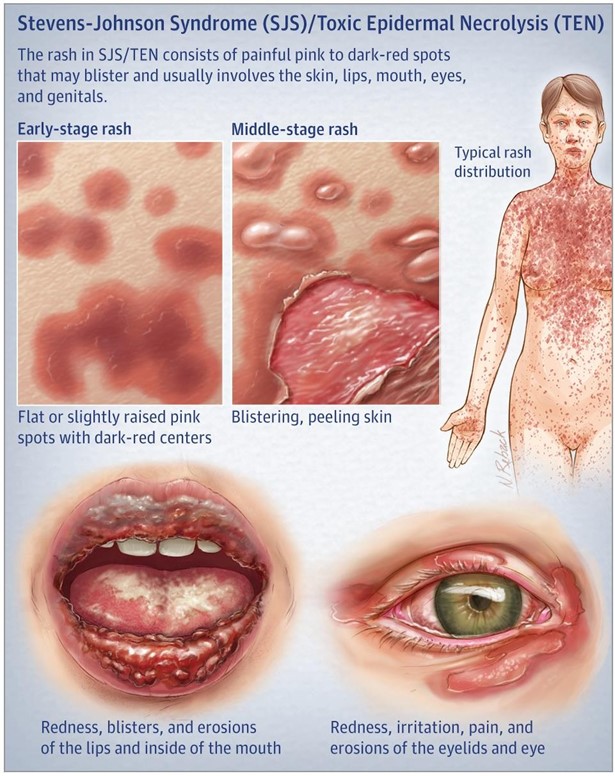A nurse is reinforcing teaching with a client who is taking allopurinol about the risk for developing Stevens-Johnson syndrome.
For which of the following manifestations should the nurse instruct the client to monitor and report?
Tinnitus with ear pain
Hyperreflexia
Skin rash with fever
Diplopia
The Correct Answer is C
Explanation
C. Skin rash with fever
Stevens-Johnson syndrome (SJS) is a severe and potentially life-threatening hypersensitivity reaction that can occur as a rare side effect of certain medications, including allopurinol.
Monitoring and early recognition of SJS symptoms are crucial for prompt medical.
Skin rash with fever is a hallmark manifestation of Stevens-Johnson syndrome. It often starts with flu-like symptoms such as fever and malaise, followed by the appearance of a widespread, painful, and rapidly progressing rash. The rash typically involves the mucous membranes, including the mouth, nose, and eyes, and can be accompanied by blisters or sores. Prompt reporting of these symptoms is critical for early diagnosis and intervention.
Tinnitus with ear pain in (option A) is incorrect because it is not typically associated with Stevens- Johnson syndrome. It may indicate another condition or side effect unrelated to SJS.
Hyperreflexia, which refers to abnormally increased reflexes, in (option B) is incorrect because it is not a characteristic manifestation of Stevens-Johnson syndrome. It may indicate a neurological condition or reaction to another medication, but it is not specific to SJS.
Diplopia, or double vision, in option (D) is incorrect because it is not commonly associated with Stevens- Johnson syndrome. It may be caused by other ocular or neurological conditions.
In summary, the nurse should instruct the client taking allopurinol to monitor and report the manifestation of a skin rash with fever. This is important because it may indicate the development of Stevens-Johnson syndrome, a severe and potentially life-threatening reaction to the medication. Early recognition and medical intervention are crucial to minimize complications and ensure appropriate treatment.

Nursing Test Bank
Naxlex Comprehensive Predictor Exams
Related Questions
Correct Answer is C
Explanation
Document the client's behavior leading to the initiation of the restraints: Accurate and comprehensive documentation is essential in the client's medical record. This includes documenting the client's behavior or actions that necessitated the use of restraints. It is important to document the reason, duration, and type of restraint used.
Release the client's restraints every 2 hours or as per institutional policy: It is important to periodically release the restraints to assess the client's circulation, skin integrity, and overall well-being. Restraints should never be kept on continuously without intermittent release. Check the client's status every 15 minutes: The nurse should closely monitor the client's vital signs, level of comfort, and any signs of distress or complications. Frequent assessment ensures early identification and intervention if any issues arise.
Obtain informed consent: While obtaining consent is necessary for many procedures or treatments, including the use of restraints, it is not applicable in situations where there is an imminent risk of harm to the client or others. The use of restraints in mental health units is based on legal and ethical guidelines, prioritizing the client's safety and the safety of others.
Correct Answer is C
Explanation
Fontanels are soft spots on an infant's skull where the bones have not yet fused together. The anterior fontanel, located at the front of the head, typically closes between 12 to 18 months of age. The posterior fontanel, located at the back of the head, usually closes by 2 to 3 months of age.
The other findings mentioned are typical developmental milestones for a 4-month-old infant:
- Rolling from back to abdomen: By 4 months of age, it is expected that infants can roll from their back to their abdomen. This is a normal developmental milestone.
- Moves objects to mouth: At 4 months, infants begin to develop hand-eye coordination and the ability to reach for objects. Bringing objects to the mouth is a typical behavior at this age as infants explore their environment.
Whether you are a student looking to ace your exams or a practicing nurse seeking to enhance your expertise , our nursing education contents will empower you with the confidence and competence to make a difference in the lives of patients and become a respected leader in the healthcare field.
Visit Naxlex, invest in your future and unlock endless possibilities with our unparalleled nursing education contents today
Report Wrong Answer on the Current Question
Do you disagree with the answer? If yes, what is your expected answer? Explain.
Kindly be descriptive with the issue you are facing.
